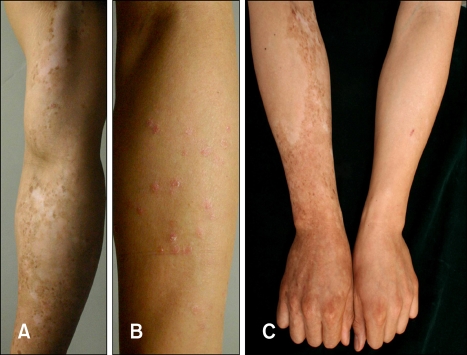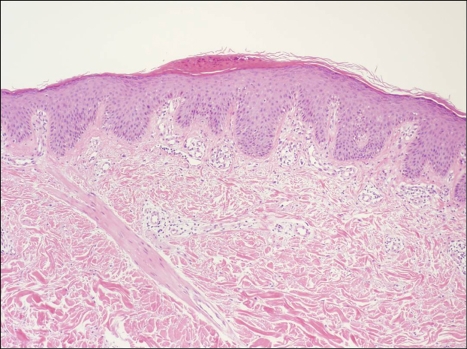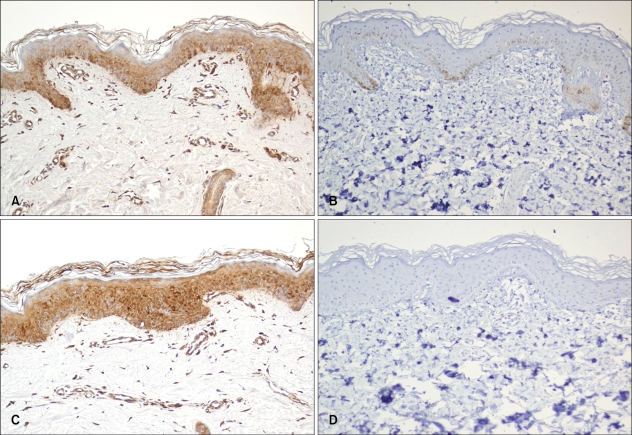Abstract
Vitiligo and psoriasis are common dermatoses that occur in 1~3% and 0.5% of the general population, respectively. There have been several reports of the concurrence of these diseases in the English medical literature. Yet the pathogenesis of the association between these two dermatoses is still unknown. Psoriasis may occur coincidentally with vitiligo and it may be strictly confined to the vitiliginous patches or it may occur elsewhere. Despite the reports in the English literature, there has been only one case of vitiligo and psoriasis coexisting in the same patient and these diseases occurred in separate sites in the Korean dermatologic literature. A 30-year-old man recently presented with spreading vitiligo on the right forearm and a 3-month history of guttate psoriasis on the left forearm. He had a family history of psoriasis without any history of associated autoimmune disease. Herein, we report on a case of coexisting vitiligo and psoriasis in the same individual at different sites and we review the relevant literature.
Keywords: Concurrent, Psoriasis, Vitiligo
INTRODUCTION
Psoriasis and vitiligo are common skin diseases that affect 1~3% and 0.5% of the general population, respectively. The first case of psoriasis accompanied with vitiligo was reported by Selenyi1 in 1955. Since then, there have been several reports of the concurrence of these diseases in the English medical literature. On a review of the literature, most cases of psoriasis coexisting with vitiligo were the plaque-type of psoriasis. The pathogenic mechanism underlying the coexistence of these diseases has not been fully elucidated. Some authors consider this coexistence to be a simple coincidence, but others have suggested a common pathogenic relationship between the two diseases. The Koebner phenomenon and genetic and environmental factors have been postulated to be involved in the development of the two diseases2,3. Since neither disease is rare in the general population, the coexistence of these two dermatoses should be expected. Although the coexistence of each disease is not uncommon in western countries, there have been only two such reports in the Korean dermatologic literature. Among the two reports of coexisting vitiligo and psoriasis, only one case report describes the occurrence of each disease in the same patient at different sites4.
Herein, we report on a case of a 30-year-old man with coexisting, newly-spreading vitiligo and psoriasis at different sites, and we review the relevant literature.
CASE REPORT
A 30-year-old man visited our Department of Dermatology with a 3-month history of a few round, erythematous patches on his left arm and he also had recently spreading hypopigmented patches on the right arm and chest. He had no significant past medical history, but he had a family history of psoriasis as his father and brother suffered from this malady. Several erythematous patches with scales on the left arm were diagnosed as guttate psoriasis (Fig. 1A). Apart from the left arm, there were diffuse, hypopigmented macules and patches on the right arm along Blaschko's line (Fig. 1B). These hypopigmented lesions had been diagnosed as vitiligo 27 years earlier. The patient had previously undergone two skin grafts that failed, and he had also been treated several rounds of PUVA without improvement. A Wood's lamp test was positive on the newly-spreading, hypopigmented lesions.
Fig. 1.
(A) Discontinuous linear hypopigmented patches from the wrist to the axillar region along the Blaschko's line on the right arm. (B) A 0.3 cm to 1 cm-sized round shaped erythematous patch with scales on the left forearm. (C) Improved erythematous patches after 4 weeks of topical steroids and the improved pigmentation on the hypopigmented patches with 308-nm excimer laser treatment.
Skin biopsy of the left arm showed parakeratotic mounds (Munro microabscess), acanthosis with elongation of the rete ridges, a diminished granular cell layer and dilated capillaries at the dermal papillae, and this was all consistent with psoriasis (Fig. 2). We performed skin biopsies on the right arm for the the hypopigmented lesion and the normal skin, and we tested the biopsied skin with S-100 protein and Melan-A to determine the number of melanocytes. Both S-100 protein and Melan-A were negative without melanocyte staining in the hypopigmented lesions as compared to the normal skin (Fig. 3). The laboratory studies that included a CBC, routine blood chemistry and tests for T3, fT4, TSH and ANA were within the normal ranges. The erythematous patches on the left arm were treated with topical steroid (Dermatop®) for 4 weeks, and after which only some postinflammatory hypopigmentation remained (Fig. 1C). The patient is now continuously receiving 308-nm excimer laser treatment on the vitiligo lesions.
Fig. 2.
Munro microabscess, psoriasiform hyperplasia of the rete ridges and the dilated and torturous vessels at the papillary dermal layer (H&E, ×100).
Fig. 3.
The normal skin of the right arm was S-100 protein positive (A) and Melan-A positive (B), and the hypopigmented lesion of the right arm was S-100 protein negative (C) and Melan-A negative (D) (×200).
DISCUSSION
Psoriasis and vitiligo are relatively common diseases in the dermatologic field. The coexistence of each disease can be expected when considering their incidence5. Although there have been well known epidemiologic studies and continuous research on psoriasis and vitiligo, their full pathogenesis is not yet clear. Furthermore, a possible link between their coexistence has not been fully elucidated. Since the first report of psoriasis and vitiligo by Selenyi1 in 1955, there have been several reports of the concurrence of these diseases in the English medical literature; however, only two cases of coexisting psoriasis and vitiligo have been reported in the Korean dermatologic literature4,6. In the case report by Lee et al.4, the psoriasis preceded vitiligo, and each lesion was located on different sites of the body. In the other case reported by Kim et al.6, the patient was treated with PUVA for the vitiligo lesions and then the psoriasis developed strictly on the vitiligo lesions. From a review of the other literature, 22 of 821 Egyptian patients and 3 of 62 British patients with vitiligo also had psoriasis7,8. In Italy, there was an interesting retrospective study of 712 patients with vitiligo9. Among the 712 patients with vitiligo, 21 (3%) patients had associated psoriasis. Among the 21 patients, psoriasis vulgaris was the most common type of psoriasis, and this occurred in 18 patients. Two patients (9.5%) had palmoplantar psoriasis, but only one patient had guttate psoriasis. Twenty-one patients had family members affected by vitiligo and psoriasis, 10 patients (47.7%) had a negative family history and only 5 (23.8%) had a family history of psoriasis alone. In terms of the onset of these diseases, psoriasis developed before the vitiligo in 6 patients (28.5%), after the vitiligo in 13 (62%), and both occurred simultaneously in 2 patients (9.5%). In terms of the distribution of the lesions, the psoriasis and vitiligo were distributed in different locations in 8 (38.1%) cases.
Arthritis, thyroid disease, diabetes mellitus, alopecia areata, bullous pemphigoid, pemphigus vulgaris, lichen planus and pernicious anemia are regarded as the associated diseases in the patients who suffer with coexisting vitiligo and psoriasis10; however, the incidence of an associated disease remains controversial. Some authors have reported that about 33% of the patients with vitiligo and psoriasis had an associated disease, but other authors have recently found an increased number of associated autoimmune disorders11. In our case, the patient's thyroid hormones and ANA levels were evaluated to detect any associated autoimmune diseases, but these results were normal.
Although the pathogenesis of the interrelationship between these two diseases is still not well understood, Sandhu et al.11 reported no increased incidence of concurrence of both diseases and they regarded their concurrence as a simple coincidence, Yet other authors have suggested several theories as a common pathogenesis for concomitant vitiligo and psoriasis. Until now, cytokines, autoimmunity, the Koebner phenomenon or decreased melanocytes have been studied as the pathogenic factors for each disease12-15. In one aspect, each disease has a common pathogenesis according to tumor necrosis factor alpha (TNF-α). Kovacs14 have demonstrated enhanced levels of neurotensin-induced TNF-α production from the melanocytes in vitiligo lesions. Jain et al.15 found an elevated level of TNF-α in the perilesional skin of patients with vitiligo. Furthermore, TNF-α is known to be one of the key cytokines in the pathogenesis of psoriasis and the level of TNF-α is elevated in psoriatic lesions16. More recently, Prignano et al.17 suggested that each disease may be immune-mediated with a genetic link.
Coexisting vitiligo and psoriasis is not an unusual phenomenon in western countries. While this coexistence was once regarded as rare, some authors have suggested the possibility of an underlying, underestimated condition. In the Korean dermatologic literature, there have been only two such reported cases of coexisting vitiligo and psoriasis, and the concurrence of these two conditions is regarded as a rare phenomenon. The rarity of this coexistence can be explained in two ways. First is the possibility of underestimation. Physicians can misdiagnose the concurrence of these two diseases or they may not report it. Also, these patients may not complain of their skin lesions as the lesions and symptoms may be mild. Secondly, there may be other genetic differences among the patients with these diseases. We presume the difference in the incidence of coexistence between races may be attributed to unique genetics, including the HLA gene or the PSORS gene.
In our case, we could not prove the interrelationship of both diseases; however, because the psoriatic lesions developed with the recurrent vitiligo lesions, we suggest that the concurrence of vitiligo and psoriasis is not a coincidence. We also believe that cytokines such as TNF-α may have played a key role in the pathogenesis of the coexistent diseases in our case. Further, extensive investigation should to be done to determine whether each disease is independent or if they both have a common pathogenesis.
Herein, we report on the third case of coexisting vitiligo and psoriasis in the Korean literature. We suggest that psoriasis and vitiligo could have a common pathogenesis and there is a different incidence of concurrence between the various races of people.
References
- 1.Selenyi A. Vitiligo and psoriasis on the same side with syringomyelia. Borgyogy Venerol Sz. 1955;9:94–96. [PubMed] [Google Scholar]
- 2.Papadavid E, Yu RC, Munn S, Chu AC. Strict anatomical coexistence of vitiligo and psoriasis vulgaris--a Koebner phenomenon? Clin Exp Dermatol. 1996;21:138–140. [PubMed] [Google Scholar]
- 3.Menter A, Boyd AS, Silverman AK. Guttate psoriasis and vitiligo: anatomic cohabitation. J Am Acad Dermatol. 1989;20:698–700. doi: 10.1016/s0190-9622(89)80158-6. [DOI] [PubMed] [Google Scholar]
- 4.Lee HC, Lim SW, Suh MK, Choi JH, Kwon SW, Lee JW, et al. A case of psoriasis vulgaris associated with vitiligo. Korean J Dermatol. 2003;41:1416–1418. [Google Scholar]
- 5.Koransky JS, Roenigk HH., Jr Vitiligo and psoriasis. J Am Acad Dermatol. 1982;7:183–189. doi: 10.1016/s0190-9622(82)70106-9. [DOI] [PubMed] [Google Scholar]
- 6.Kim YJ, Kang HY, Lee ES, Kim YC. A case of psoriasis strictly localized on a vitiligo lesion. Korean J Dermatol. 2006;44:528–530. [Google Scholar]
- 7.el-Mofty AM, el-Mofty M. Vitiligo. A symptom complex. Int J Dermatol. 1980;19:237–244. doi: 10.1111/j.1365-4362.1980.tb00316.x. [DOI] [PubMed] [Google Scholar]
- 8.Bor S, Feiwel M, Chanarin I. Vitiligo and its aetiological relationship to organ-specific autoimmune disease. Br J Dermatol. 1969;81:83–88. doi: 10.1111/j.1365-2133.1969.tb15985.x. [DOI] [PubMed] [Google Scholar]
- 9.Percivalle S, Piccinno R, Caccialanza M. Concurrence of vitiligo and psoriasis: a simple coincidence? Clin Exp Dermatol. 2009;34:90–91. doi: 10.1111/j.1365-2230.2008.02908.x. [DOI] [PubMed] [Google Scholar]
- 10.De Sica AB, Wakelin S. Psoriasis vulgaris confined to vitiligo patches and occurring contemporaneously in the same patient. Clin Exp Dermatol. 2004;29:434–435. doi: 10.1111/j.1365-2230.2004.01555.x. [DOI] [PubMed] [Google Scholar]
- 11.Sandhu K, Kaur I, Kumar B. Psoriasis and vitiligo. J Am Acad Dermatol. 2004;51:149–150. doi: 10.1016/j.jaad.2003.12.014. [DOI] [PubMed] [Google Scholar]
- 12.Dhar S, Malakar S. Colocalization of vitiligo and psoriasis in a 9-year-old boy. Pediatr Dermatol. 1998;15:242–243. [PubMed] [Google Scholar]
- 13.Boyd AS, Neldner KH. The isomorphic response of Koebner. Int J Dermatol. 1990;29:401–410. doi: 10.1111/j.1365-4362.1990.tb03821.x. [DOI] [PubMed] [Google Scholar]
- 14.Kovacs SO. Vitiligo. J Am Acad Dermatol. 1998;38:647–666. doi: 10.1016/s0190-9622(98)70194-x. [DOI] [PubMed] [Google Scholar]
- 15.Jain R, Dogra S, Sandhu K, Handa S, Kumar B. Coexistence of vitiligo and pemphigus vulgaris in an indian patient. Pediatr Dermatol. 2003;20:369–370. doi: 10.1046/j.1525-1470.2003.20326_1.x. [DOI] [PubMed] [Google Scholar]
- 16.Victor FC, Gottlieb AB, Menter A. Changing paradigms in dermatology: tumor necrosis factor alpha (TNF-alpha) blockade in psoriasis and psoriatic arthritis. Clin Dermatol. 2003;21:392–397. doi: 10.1016/j.clindermatol.2003.08.015. [DOI] [PubMed] [Google Scholar]
- 17.Prignano F, Pescitelli L, Ricceri F, Lotti T. The importance of genetical link in immuno-mediated dermatoses: psoriasis and vitiligo. Int J Dermatol. 2008;47:1060–1062. doi: 10.1111/j.1365-4632.2008.03699.x. [DOI] [PubMed] [Google Scholar]





